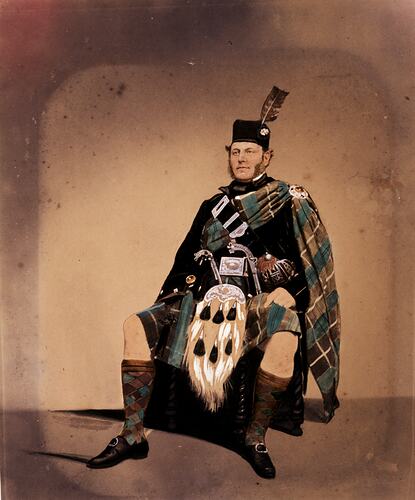Summary
Reproduction of a handcoloured photographic portrait of Niel Black in full Scottish regalia, circa 1860s.
When Niel Black first arrived in Victoria in 1839, he declared that it was `a Scotch settlement, and the people are so far as I can judge altogether Scotch.' While this was somewhat of an exaggeration, Scottish immigrants formed almost one fifth of the population of the new colony. Born in Scotland in 1804, he arrived in Victoria in 1839 as an ambitious 35-year-old and an experienced farmer. He never intended to stay in Australia for long, planning to make his fortune and then return home. Three business partners back in Scotland and Liverpool financed him, confident of a healthy return on their investment. Black was attracted to the rich volcanic soil of Western Victoria, and leased a large grazing run near Terang, renaming it Glenormiston. He kept himself informed of the latest agricultural practice from abroad, and imported livestock to improve the quality of his sheep and cattle. In the 1850s he went back to Scotland for five years to acquaint himself with the latest farming techniques, returning with a young wife Grace Leadbetter. The `NB' branding symbol was prized in the market places in Melbourne. Black cultivated a number of crops at Glenormiston, but he was most successful with the breeding of cattle and sheep. He imported Durham bulls and Anglo-merino sheep from Europe in the hope of improving the quality of his stock. He also introduced fencing to Glenormiston during the 1850s, which replaced the need for shepherds.
Black built Glenormiston into one of the wealthiest properties in the colonies, but he had an ongoing battle to retain his land. In the 1850s, the Victorian Government began to restrict the amount of land Squatters like Black could own and trade. Black was persuaded to stand for Parliament to protect the Squatters' interests, and remained a member of the Legislative Council until his death. Although he sometimes considered returning to Scotland permanently, he always decided to remain. In 1868 he did lose his beloved Glenormiston homestead when the company was wound up and its assets distributed amongst the partners. Black was given the adjoining land at Mount Noorat. His descendants continue to live on some of the land that Black first farmed over 150 years ago. Niel Black died in 1880.
Niel Black chose to leave his homeland and come to Australia, planning to make his fortune and then return to Scotland.
There are many other people entwined in Niel Black's story that were not so fortunate. People who were forced to leave their homes, due to famine, oppression, disease, and threat to their lives. From the late 18th century, an agricultural revolution was sweeping through Scotland. Land was cleared for sheep farming, resulting in large numbers of small farmers being driven from their properties. Between 1800 and 1830 the population also grew dramatically, putting increased pressure on the land. In the 1830s the colonial government decided to subsidise fares to Australia under the Bounty Immigration Scheme. Employers made use of the scheme to bring experienced workers out from Britain. Niel Black's early work force consisted mainly of Scottish Highlanders brought to Australia in this way.
While Scottish Highlanders were forced to cross the globe, and found themselves working Black's lands, Aboriginal people throughout the western district found themselves equally displaced. As Black and other squatters like him took up more and more land, the original owners of those lands were dispossessed. It was a treatment they frequently rebelled against, resulting in the taking of livestock and violent conflict. There are many stories of intimidation by colonials of the Aborigines, of threats, poisonings, injury and killings. Black's diaries record such incidents, which he describes at times with regret, although more often with resignation and complicity.
Description of Content
Niel Black in full Scottish regalia, circa 1860s.
Physical Description
Reproduction of an original hand tinted photograph.
More Information
-
Collecting Areas
-
Acquisition Information
Copied from Black Family, 2002
-
Person Depicted
-
Format
Photograph, Hand Coloured
-
Classification
Migration, Settlement - cultural & social life, Family portraits
-
Category
-
Discipline
-
Type of item
-
Image Dimensions - Photograph
210 mm (Width), 250 mm (Height)
-
References
Note this image appeared in the exhibition catalogue 'For auld lang syne: images of Scottish Australia from First Fleet to Federation, curated by Alison Inglis and Patricia Tryon Macdonald', Art Gallery of Ballarat, Ballarat, Victoria 2014, p.71
-
Keywords
Scottish Communities, Scottish Immigration, Rural Victoria, Rural Life, Aboriginal Contact, Tartan, Kilts
